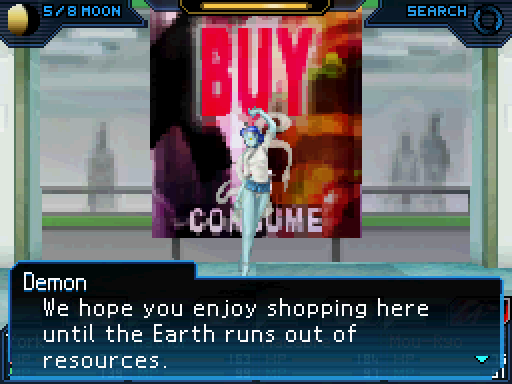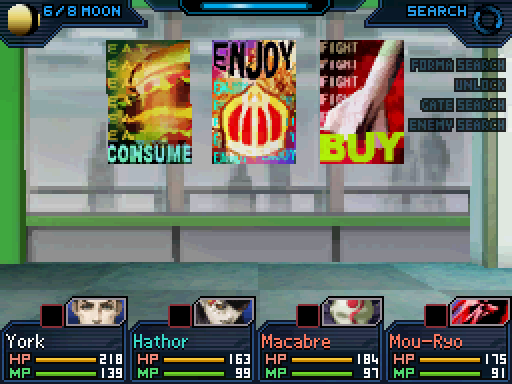The scariest moment in gaming I've experienced? Accidentally saving over a near-endgame file of Final Fantasy Tactics Advance. I've not really played any horror games. Not because I don't want to, I've just never really gotten around to it.
Hopefully not having played the first 3 Silent Hills won't invalidate my opinions as a Person Wot Writes About Games; but until I eventually play them, there are a few times where a game has been successfully unsettling. The one that's still stuck with me is from Shin Megami Tensei: Strange Journey.
As a series, the Shin Megami Tensei games (this is excluding Persona and other spinoffs, mind) are very thematically similar. You, a lowly human have been gifted with the technology to summon demons to fight by your side, while a ridiculous catastrophic event goes on around you. Depending on how you react to certain story choices, you gain a Chaotic/Lawful alignment (intentionally not just 'good/evil', though often it pans out to be the same).
Where Strange Journey differs is its setting - a series of twisted worlds called the Schwarzwelt. Created by demons, it represents the ills of the human condition. You play as a soldier of a global army, investigating the Schwarzwelt in an attempt to destroy it; though you quickly find yourself unable to escape.
Welcome to Sector Carina
Up to a point, each location in the game plays up a problem with humanity, with a surreal twist. A lot of these areas don't have the impact they should (which I will discuss later), but the third area, Sector Carina is meant to represent humanity's greed, being a gigantic demon shopping mall.

And you know what? It really creeped me out. Sadly, not entirely due to the game's aesthetics, but at least partially! Sector Carina was clever in being uncanny. At first look, everything does look like an ordinary shopping mall (through the filter of low-quality textures on a DS screen), but then you talk to the first NPC:

And then you look at the posters and the shop windows:

And then you pay attention to the slow, militaristic waltz used as background music:
And it settles in that this is a shopping mall with all of the pretence stripped away. Everything you could ever want is within these walls (along with a whole lot of stuff you don't), and your only company are towering urges to BUY, EAT, and CONSUME.
Relevance in a Riot
I was playing Strange Journey in August 2011, and reached Sector Carina during the time when the England Riots occurred. For those who aren't familiar, a riot broke out in Tottenham, a district of London, on the 7th of August. What had started out as a protest against police corruption and brutality in the area took a turn for the violent once someone decided to throw a bottle when the police arrived to suppress the protest. Things escalated quickly, with shops smashed and ransacked, and arson attempts. Once it started, similar riots sprang up all across London, and then into other, unrelated cities of England.

On the day they had started, I happened to already be in the centre of town, watching Croydon slowly go up in flames on BBC News. Had I not gone home when I did, the underground and bus services would have closed, leaving me stranded on Tottenham Court Road. I get home by sundown and find through Twitter that even my local high street had rioters.
While the area where I lived wasn't especially wealthy, it didn't have economic and police problems as severe as the ones in Tottenham. As I found out more about the event, it became woefully apparent that the majority of the rioters weren't causing anarchy for any kind of cause, other than their own pockets.
In a way, even though what happened is incredibly sad, I empathise. People riot in pursuit of aspirations, and ideally you'd want those aspirations to be political. However, many of us (and I'm including myself here) have aspirations that don't extend too far beyond our economic status, the next pair of shoes, the next luxury meal, the next tablet computer.
That some of us are willing to go to the lengths of destruction just to get it (along with the vague promise that you won't get caught) is actually pretty scary! It weighed on my mind, as I progressed through Carina, being told that the area was run by the demon Horkos, a glutton so dedicated, it ate an entire space craft, filled with the protagonist's comrades. Drawing a parallel between materialism and violence is heavy-handed, but it's not exactly incorrect.
It is later implied through some side-NPC dialogue that the layout of the Sector was based on a human shopping mall. This kind of M. Night Shyamalan twist made me roll my eyes, but then, the Westfield shopping mall in Stratford opened.
Retail Therapy & Theming Consistency

It's hardly likely to be the largest shopping complex out there, but I felt dwarfed by Westfield Stratford's size when I visited in its opening week. It had a casino. It had a 10-screen cinema. It had a food court that took up almost a third of the whole complex, with every kind of regional cooking speciality. It's the kind of place that would get anti-capitalists and anti-consumerists feeling violently ill, but I actually, honestly enjoy that kind of thing.
As I walk around, I recall Sector Carina and suddenly feel awkward. I make a realisation. For once, the moral soapboxing in a piece of media is about me. Funnily enough, by being very faithfully tied to the rules of what makes an Atlus JRPG, Strange Journey keeps its theme and its gameplay woefully separated. It hamstrings the entire game, really.
While I couldn't get emotionally invested with the themes of war or lust, if they'd taken the time to do something to make those ideas relevant to the player, they'd have more impact. It makes Sector Carina's effectiveness something of an accident. While the stage itself didn't do anything to make you think about greed via the game mechanics, materialistic greed is something that I can admit to having done in the past, way more than bloodthirstiness or careless environmental destruction or (sadly) wanton hedonism. Sector Carina was effective because the setting has (at least for me) some real-life parallels; not just a strawman argument of humanity.
While my experience with Strange Journey is very much down to circumstance, the aesthetic and theme of Sector Carina could still be used in other games. Commerce as Horror is something not really explored, unless you count Dead Rising (you shouldn't) or one of the stages in Illbleed (which does use greed as a mechanic, impressively). No one should experience their neighbourhood being torn apart in the pursuit of goods in real life, but they can damn sure could see it done in a game.
N.B.: You can read about the finer details of the 2011 riots at the Guardian here. The information is surprisingly extensive.











